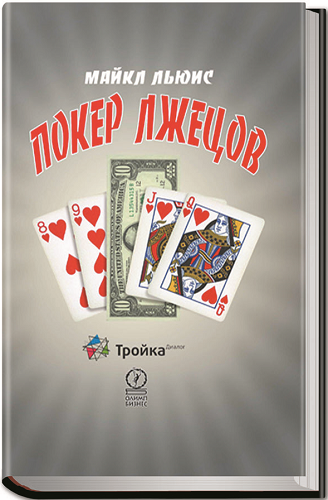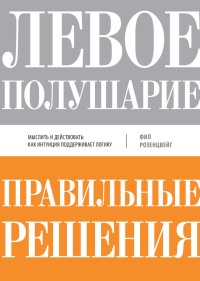Читать книгу - "Левое полушарие-правильные решения. Мыслить и действовать. Как интуиция поддерживает логику - Фил Розенцвейг"
Аннотация к книге "Левое полушарие-правильные решения. Мыслить и действовать. Как интуиция поддерживает логику - Фил Розенцвейг", которую можно читать онлайн бесплатно без регистрации
College Board. Student Descriptive Questionnaire. Princeton, NJ: Educational Testing Service, 1976–1977.
Corporate Finance Advisory and Mergers&Acquisitions. “Uncorking M&A: The 2013 Vintage.” J. P. Morgan, December 2012.
Craggs, Tommy. “Say-It-Ain’t-So Joe.” SF Weekly, July 6, 2005, http://www.sfweekly.com/2005–07–06/news/say-it-ain-t-so-joe.
Critchley, Simon, and Jamieson Webster. “The Gospel According to ‘Me’.” New York Times, June 30, 2013, SR8.
DeBondt, Walter F., and Richard H. Thaler. “Financial Decision-Making in Markets and Firms: A Behavioral Perspective.” Handbooks in OR&MS 9 (1995): 385–410.
Dew, Nicholas, Saras Sarasvathy, Stuart Read, and Robert Wiltbank. “Affordable Loss: Behavioral Aspects of the Plunge Decision.” Strategic Entrepreneurship Journal 3 (2009): 105–126.
Diaz, Jaime. “Perils of Putting: Duffers, Take Heart. A New Study by the PGA Tour Reveals That When It Comes to Putting, the Pros Aren’t So Hot Either.” Sports Illustrated, April 3, 1989.
Dosi, Giovanni, and Dan Lovallo, “Rational Entrepreneurs or Optimistic Martyrs? Some Considerations on Technological Regimes, Corporate Entries, and the Evolutional Role of Decision Biases.” In Technological Innovation: Oversights and Foresights, edited by Raghu Garud, Praveen Nattar Nayyar, and Zur Baruch Shapira, 41–68. New York: Cambridge Innovation: Oversights and Foresights, edited by Raghu Garud, Praveen Nattar Nayyar, and Zur Baruch Shapira, 41–68. New York: Cambridge University Press, 1997.
Dubner, Stephen J., and Steven D. Levitt. “A Star Is Made.” New York Times, May 7, 2006, http://www.nytimes.com/2006/05/07/magazine/07wwln_freak.html?pagewanted=all.
Dunne, Timothy, Mark J. Roberts, and Larry Samuelson. “Patterns of Firm Entry and Exit U. S. Manufacturing Industries.” Rand Journal of Economics 19, no. 4 (Winter 1988): 233–271.
Eckhardt, Roger. “Stan Ulam, John von Neumann, and the Monte Carlo Method.” Los Alamos Science 15, Special Issue (1987): 131–137.
Eichler, Jeremy. “String Theorist: Christian Tetzlaff Rethinks How a Violin Should Sound.” New Yorker, August 27, 2012, 34–39.
Ericsson, K. Anders, Ralf Th. Krampe, and Clemens Tesch-Rцmer. “The Role of Deliberate Practice in the Acquisition of Expert Performance.” Psychological Review 100, no. 3 (1993): 363–406.
Ericsson, K. Anders, Michael J. Prietula, and Edward T. Cokely, “The Making of an Expert,” Harvard Business Review, July—August 2007, 114–121.
Feynman, Richard P. “What Is and What Should Be the Role of Scientific Culture in Modern Society.” Address to the Galileo Symposium, Italy, 1964. In The Pleasure of Findings Things Out: The Best Short Works of Richard P. Feynman, 106–107. London: Penguin, 1999.
Fienberg, Stephen E. “When Did Bayesian Inference Become Bayesian?” Bayesian Analysis 1, no. 1 (2006): 1–40.Fisher, Kenneth L. “The Eight Biggest Mistakes Investors Make.” UT Today 1 (2007): 50–53.
Flyvbjerg, Bent, Mette K. Skamris Holm, and Suren L. Buhl. “How (In) Accurate Are Demand Forecasts in Public Works Projects?” Journal of the American Planning Association 71 (2005): 131–146.
“Former FEMA Chief Says Bush Was Engaged but Overconfident.” Associated Press, March 1, 2006, http://www.foxnews.com/story/0,2933,186546,00.html.
Fox, Jeremy. “Frequentist vs. Bayesian Statistics: Resources to Help You Choose,” http://oikosjournal.wordpress.com/2011/10/11/frequentistvs-bayesian-statistics-resources-to-help-you-choose/.
Friedman, Thomas L. “Obama’s Best-Kept Secrets.” New York Times, October 21, 2012, SR1.
Gapper, John. “McKinsey’s Model Springs a Leak.” Financial Times, March 10, 2011, 9.
Gawande, Atul. “The Bell Curve: What Happens When Patients Find out How Good Their Doctors Really Are?” New Yorker, December 6, 2004, 82–91.
Gino, Francesca, Zachariah Sharek, and Don A. Moore. “Keeping the Illusion of Control Under Control: Ceilings, Floors, and Imperfect Calibration.” Organizational Behavior and Human Decision Processe 114, no. 2 (March 2011), 104–114.
Goffee, Robert, and Gareth Jones. “Managing Authenticity: The Great Paradox of Leadership.” Harvard Business Review (December 2005): 87–94.
Gollwitzer, Peter M., and Ronald F. Kinney. “Effects of Deliberative and Implemental Mind-sets on Illusion of Control.” Journal of Personality and Social Psychology 56, no. 4 (1989): 531–542.Goodstein, Laurie. “Serenity Prayer Skeptic Now Credits Niebuhr.” New York Times, November 28, 2009, A11.
Gopnik, Adam. “Life Studies: What I Learned When I Learned to Draw.” New Yorker, June 27, 2011, 56–63.
“Greater Prudhoe Bay,” BP Fact Sheet, http://www.bp.com/liveassets/bp_internet/globalbp/STAGING/global_assets/downloads/A/abp_wwd_alaska_prudhoe_bay_fact_sheet.pdf.
Hambrick, David Z., and Elizabeth J. Meinz. “Sorry, Strivers: Talent Matters.” New York Times, November 20, 2011, SR12.
Hardy, Quentin. “Intel Tries to Secure Its Footing Beyond PCs,” New York Times, April 15, 2013, B1.
Harford, Tim. “Screening: It’s All in the Numbers.” Financial Times/FT.com Magazine, December 10/11, 2011.
Hayward, Mathew L. A., Dean A. Shepherd, and Dale Griffin. “A Hubris Theory of Entrepreneurship.” Management Science 52, no. 2 (2006): 160–172.
Headd, Brian. “Redefining Business Success: Distinguishing Between Closure and Failure.” Journal Small Business Economics. 1 (1) (2004): 51–61.
Hogarth, Robin M., and Natalia Karelaia. “Entrepreneurial Success and Failure: Confidence and Fallible Judgment.” Organization Science 23 (2012): 1733–1747.
Humphrey, Elizabeth King. “Be Sad and Succeed.” Scientific American, March 3, 2010, http://www.scientificamerican.com/article.cfm?id=besad-and-succeed.
Kahneman, Daniel, and Amos Tversky. “On the Psychology of Prediction.” Psychological Review 80 (1973): 237–257.
Kahneman, Daniel, Dan Lovallo, and Olivier Sibony. “Before You Make that Big Decision…” Harvard Business Review (June 2011): 51–60.
Keogh, Brian. “Harrington and the Man with Two Brains.” Irish Golf News, March 6, 2013, http://www.irishgolfdesk.com/news-files/2013/3/6/harrington-and-the-man-with-two-brains.html.
Прочитали книгу? Предлагаем вам поделится своим впечатлением! Ваш отзыв будет полезен читателям, которые еще только собираются познакомиться с произведением.
Оставить комментарий
-
 Вера Попова27 октябрь 01:40
Любовь у всех своя-разная,но всегда это слово ассоциируется с радостью,нежностью и счастьем!!! Всем добра!Автору СПАСИБО за добрую историю!
Любовь приходит в сентябре - Ника Крылатая
Вера Попова27 октябрь 01:40
Любовь у всех своя-разная,но всегда это слово ассоциируется с радостью,нежностью и счастьем!!! Всем добра!Автору СПАСИБО за добрую историю!
Любовь приходит в сентябре - Ника Крылатая
-
 Вера Попова10 октябрь 15:04
Захватывает,понравилось, позитивно, рекомендую!Спасибо автору за хорошую историю!
Подарочек - Салма Кальк
Вера Попова10 октябрь 15:04
Захватывает,понравилось, позитивно, рекомендую!Спасибо автору за хорошую историю!
Подарочек - Салма Кальк
-
 Лиза04 октябрь 09:48
Роман просто супер давайте продолжение пожалуйста прочитаю обязательно Плакала я только когда Полина искала собаку Димы барса ♥️ Пожалуйста умаляю давайте еще !))
По осколкам твоего сердца - Анна Джейн
Лиза04 октябрь 09:48
Роман просто супер давайте продолжение пожалуйста прочитаю обязательно Плакала я только когда Полина искала собаку Димы барса ♥️ Пожалуйста умаляю давайте еще !))
По осколкам твоего сердца - Анна Джейн
-
 yokoo18 сентябрь 09:09
это прекрасный дарк роман!^^ очень нравится
#НенавистьЛюбовь. Книга вторая - Анна Джейн
yokoo18 сентябрь 09:09
это прекрасный дарк роман!^^ очень нравится
#НенавистьЛюбовь. Книга вторая - Анна Джейн





